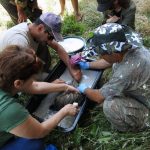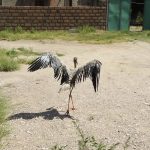
Photographs of oil-covered storks that have emerged online have reignited fears from environmentalists over the fate of the birds in Armenia.
According to the Armenian Environmental Front, a group of activists visited several villages in the central Ararat and Armavir provinces on 4 July and identified 65 of the birds covered in oil.
Activists have laid the blame on fisheries in the region, which they accuse of polluting the areas where storks feed.
The Ministry of the Environment has also suggested fisheries were to blame.
In a statement on 7 July, the ministry said the were monitoring villages with significant stork populations and had been able to trace where storks were feeding and possible pollution sources.
‘Based on preliminary data, it has become clear that the majority of the polluted birds go near the fisheries to feed which is the probable cause for the oil covering,’ the statement reads.
‘Research has shown that 60% of the birds nesting between the villages of Hovtashen, Eraskhahun, and Hayanist [in the Ararat and Armavir provinces] have been polluted.’
The ministry said they would request that the Inspectorate for Nature Protection and Mineral Resources investigate the fisheries they had identified.
‘The solution to the pollution of storks is at the forefront of the Ministry of Environment’s attention,’ the statement concluded.
Local residents posted photos and videos of storks struggling to fly.
On 8 July, the Inspectorate announced it had sent contaminated feather samples to a laboratory for examination and would soon inspect several businesses near stork populations.
This is not the first time that oil-covered storks have caused concern. In the summer of 2019, local residents and environmentalists in Ararat and Armavir found storks covered in what appeared to be oil. After drying their feathers, the substance prevented the storks from taking flight, with several dying as a result.
While the authorities initially launched a criminal investigation on water pollution charges, on 22 May, shortly before the latest picture emerged, the Investigative Committee informed Hetq they had dropped the case as they had found insufficient evidence that a crime was committed.
According to the committee, it was not possible to establish when, where, or how the birds’ feathers were covered in oil or exactly what the substance itself was.
A living symbol
The stork features prominently in Armenian folklore and songs, often as a symbol of prosperity and wealth and symbolising the coming of spring.
Up to 300 of the birds stay in the country over the winter.
The birds typically nest on rooftops and high electrical poles in the villages of Ararat and Armavir provinces.
Up until the 1970s, the birds nested only temporarily before migrating to Africa and the Arabian Peninsula. However, after fisheries were introduced, a small local population developed.
When oil-contaminated storks were first discovered in 2019, samples of their feathers were sent to laboratories which concluded that at least 20% of the substance was composed oil originating from food production.
According to Artur Beglaryan, Head of the Animal Oversight Department at the State Inspectorate for Nature Protection and Mineral Resources, the remaining 80% could not be identified due to a lack of appropriate laboratory equipment.
At the time, several dozen volunteers in Yerevan were able to capture and clean 22 storks. However, the effort was not enough to save all of the contaminated birds.
According to Lyuba Balyan, a researcher at the Scientific Center of Zoology and Hydro-ecology, soon after the oil-covered storks were discovered, the centre registered a drop in the number of storks.
As many as 100 storks may have perished, she said.
The first to link the pollution to fisheries was Karen Aghababyan, an ornithologist and head of Towards Sustainable Ecosystems, a local environmental group.
According to him, sturgeon fish farms were throwing large quantities of fish remains, which contained oil, into nearby rivers leading to clogged canals where storks would scavenge for food.









